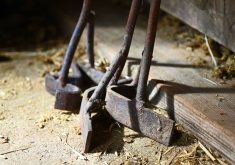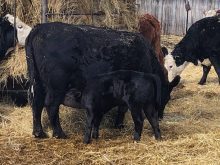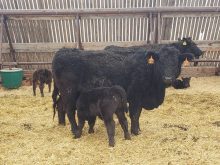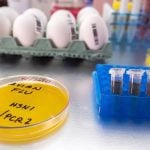I had the privilege of presenting a replacement female course in the Maritimes this fall (after three years or so of COVID, and airport-related delays). It provided a good opportunity to take some time to think through replacement strategies and the actual issues surrounding replacements.
Most of us underestimate the replacement rate of our cow herds. A figure often brought up in conversation would be 10 per cent of the cow herd needs replacement, but in reality, for most of us it is probably closer to 20 per cent. To maintain a constant cow herd size, the replacement rate is simply the number of open cows + aged cows + cull cows + deaths divided by the opening number of cows.
While your numbers will be different, let’s illustrate with some realistic numbers from a 100-head cow herd. We will start the year with 100 cows. A good conception rate could be 95 per cent. That means at preg-check time, we would remove five cows. If we had a 97 per cent calving survival rate (three dead calves) we would add three more cows to the cull list.
Read Also

Harvest wraps up and fall work begins
At the Eppich famly ranch in western Saskatchewan, the fall harvest was successful with few breakdowns, cows and calves have been sorted and a new tractor has arrived
We will assume a 98 per cent survival-to-weaning rate, which adds two more cows to the cull pile. We had a very good year and only one cow died over the summer.
Notice in this example we are already over a 10 per cent replacement rate, and we have not removed any cows for age, udders, disposition or other afflictions. Depending on how much pressure you may put on these types of traits, it starts to become evident how our replacement rate might be higher than we normally consider. The other important consideration is that culling rates tend to be higher for younger cows (two- to three-year olds) than for older cows (five- to eight-year olds). This may be due to a combination of factors, but primarily the added requirements for a first-calf heifer that is recovering post-estrus, producing milk and still growing while trying to rebreed puts her in a challenging scenario. Often these heifers will produce a calf and rebreed, but may be in poor body condition at weaning and may require additional management in order to breed the next year as a three-year old.
The replacement strategy
For these and other reasons, most cow herds do not have a perfectly smooth age distribution and will tend to have a disproportionate number of these younger females. Regardless, at some point a strategy to replace cows removed from the herd is required.
One of the most common approaches is to retain your female calves at weaning and breed them to replace the old/open or otherwise cows sold out of the herd. There are some advantages to this approach as the heifers may already be familiar with the terrain, grazing patterns and management and may be built from genetics selected specifically for your ranch. It is also important to realize that those retained heifers represent a potentially lost marketing opportunity, as they could have been sold at any point previous. Additionally, the heifers will take grazing capacity or use grass that could have otherwise been consumed by a cow raising a marketable calf. It is possible that extra heifers, once bred, may be marketed at a premium.
Another approach that we see over the fall and winter is the purchase of bred heifers from other operations. This can be a good strategy if you can purchase groups that fit your management. As mentioned previously, these females often take a little extra care in the first year as they are calving, growing, raising a calf and rebreeding. Often the replacement rate on these groups of animals can be quite high without that extra level of management. When these heifers fall out of the herd early on, the depreciation cost can be quite high, particularly if a premium was paid for the heifers.
Still more options
While retaining or buying heifers are the two most common replacement strategies, they are far from the only options. Remember, we don’t need heifers, we need replacement cows. This can be accomplished by buying bred cows or even pairs.
Advantages of this approach are that cows will tend to raise bigger calves than heifers, you will generally avoid calving difficulties and rebreeding success is more likely as the cows have reached a mature equilibrium physiologically. The purchase price is also often lower than a similar-quality bred heifer. Additionally, the grass/feed that is freed up from retaining heifers can be used to potentially run more cows that are raising a marketable calf.
Concerns may include disease/vaccination or herd health status of these cows, as well as the availability of consistent, high-quality animals. We don’t want to buy someone else’s problem, but I do think this strategy is often overlooked by many as an option due to often overstated concerns.
Another add-on type of strategy may include the use of sexed semen. It is possible to buy semen for use via artificial insemination that can produce 90 per cent-plus of one sex or another. In the example of retaining heifers to breed, it may be possible to breed a smaller group of females to produce replacement-quality heifers, thus freeing up other cows in the herd to produce market calves.
Replacement strategies are an important aspect of a cow-calf business. When we consider that a typical replacement rate is in the range of 20 per cent, it means that 20 per cent of the marketings from the operation are in the form of cull cows and not feeder cattle or calves. It also means that we have a significant expense in replacing cows. Thinking through a good replacement strategy is a vital exercise. It will also likely result in slightly different approaches for every operation. There is a lot of good information available on the Beef Cattle Research Council website at beefresearch.ca.















